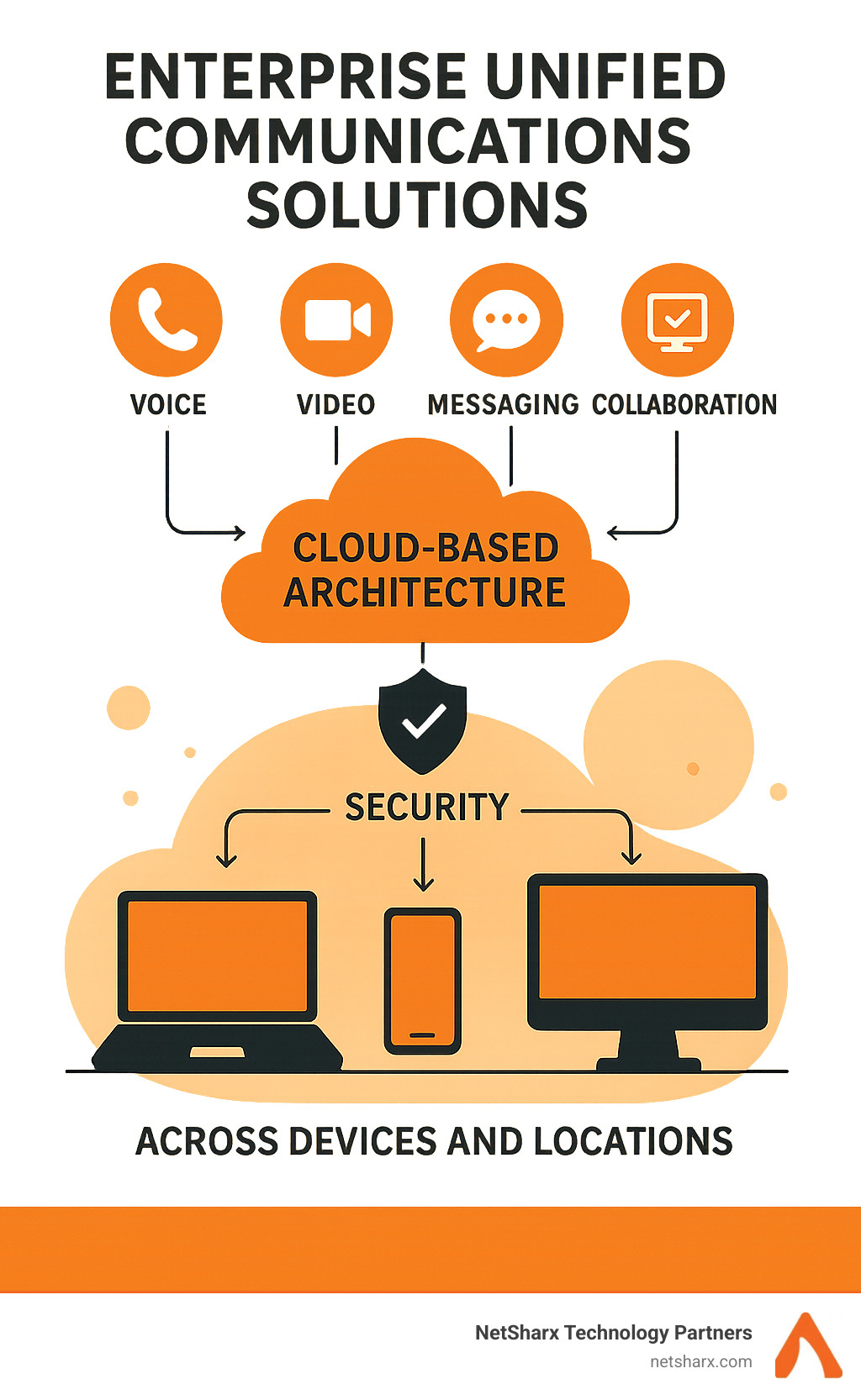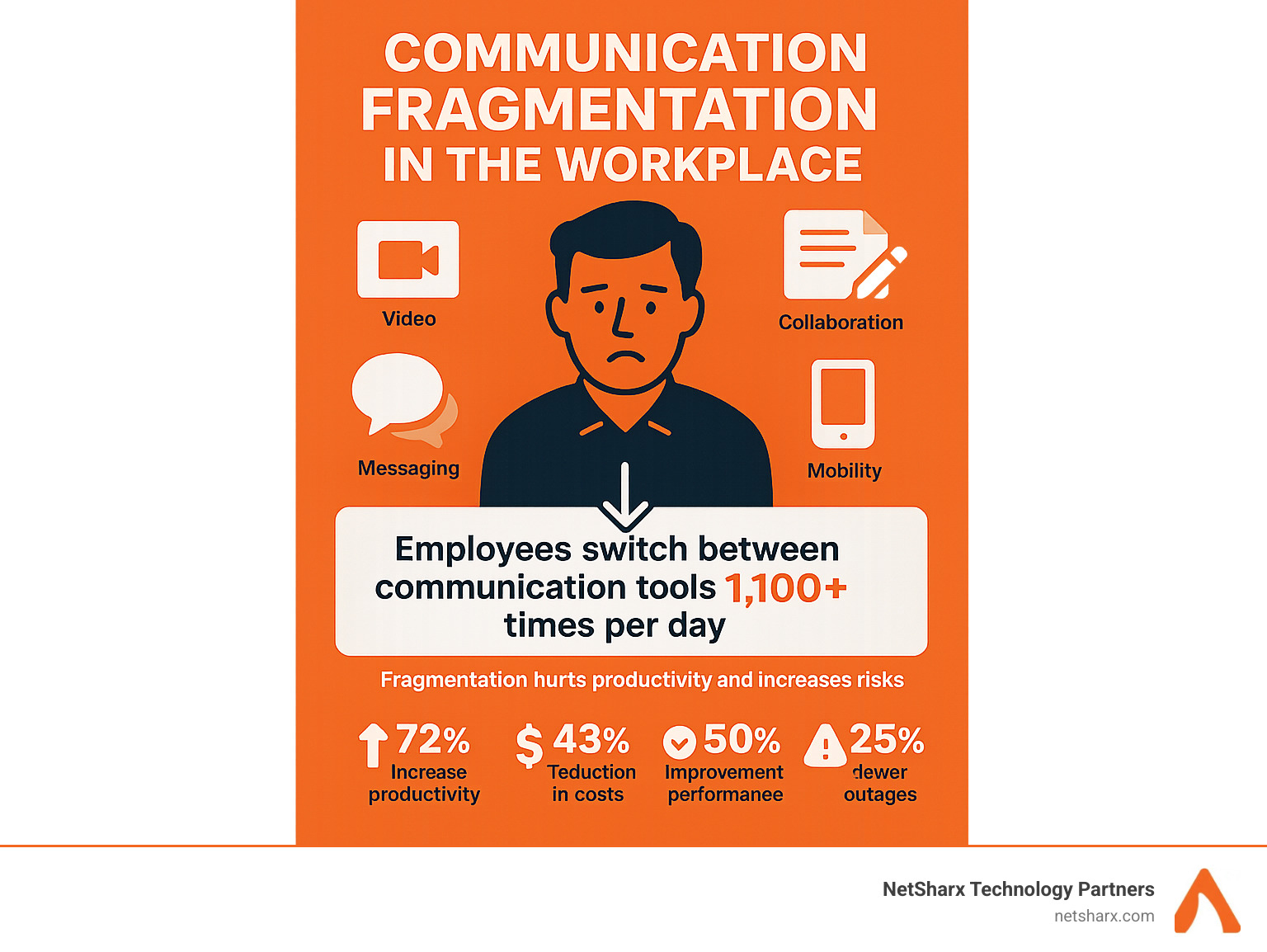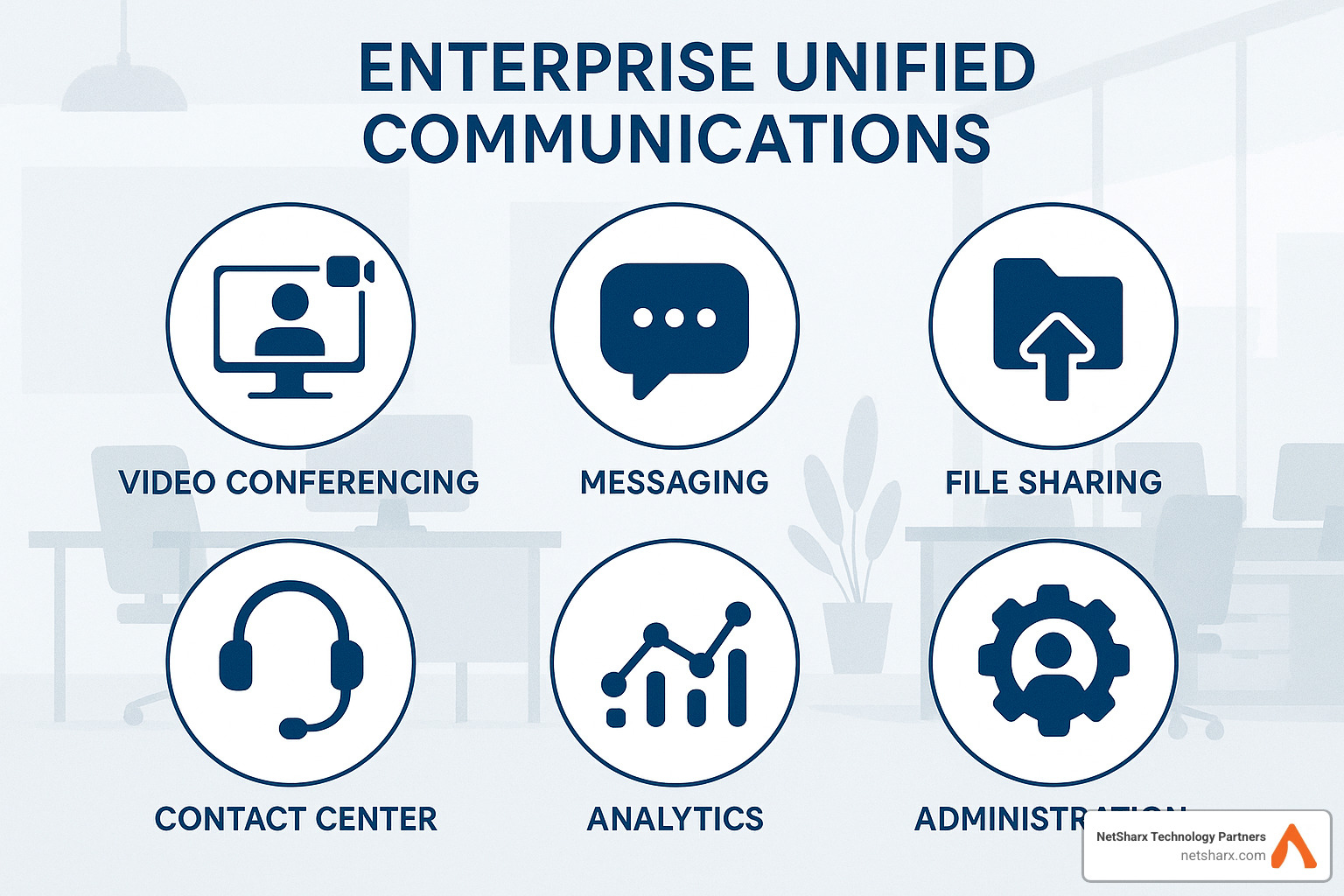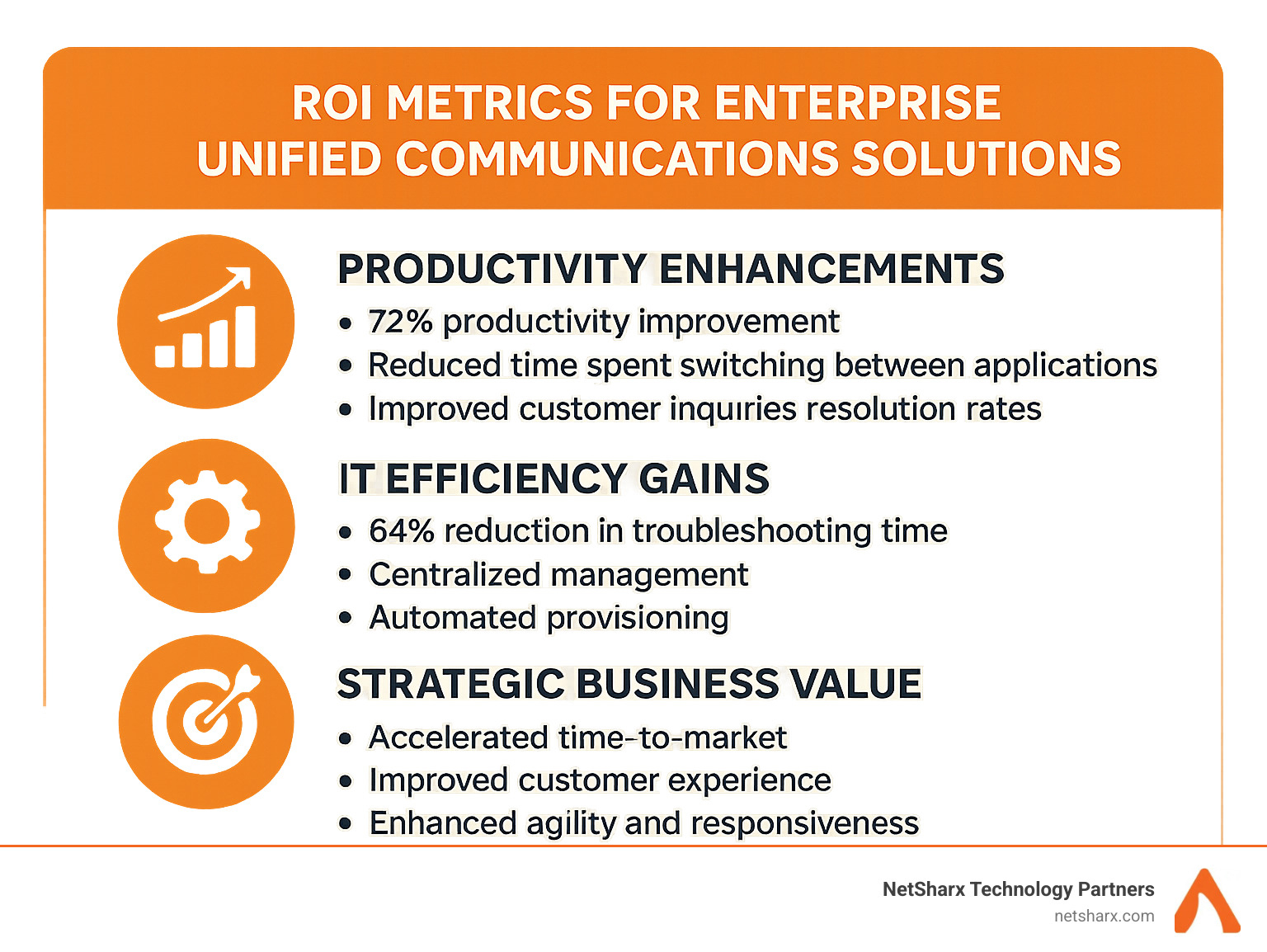Enterprise Unified Communications Solutions: 7 Powerful Benefits 2025
Bridging the Communication Gap in Today’s Digital Workplace
Enterprise unified communications solutions integrate multiple communication channels—voice, video, messaging, and collaboration tools—into a single, cohesive system accessible across devices and locations.
What are enterprise unified communications solutions?
| Feature | Description |
|---|---|
| Voice & Telephony | Cloud calling, VoIP, and virtual PBX replacing traditional phone systems |
| Video Conferencing | HD meetings with screen sharing, recording, and virtual backgrounds |
| Messaging | Instant messaging, team chat, and presence indicators |
| Collaboration | Document sharing, whiteboarding, and real-time co-editing |
| Mobility | Seamless experience across desktop, mobile, and browser interfaces |
| Integration | APIs connecting with CRM, ERP, and business applications |
The average enterprise employee switches between communication tools over 1,100 times per day—that’s once every 30 seconds during working hours. This fragmentation wastes time, creates confusion, and increases security risks.
The global unified communications market is forecasted to reach USD 167.1 billion by 2025, driven by the massive shift to remote and hybrid work models. Organizations implementing unified communications solutions report significant improvements:
- 72% increase in productivity
- 43% reduction in operational costs
- 50% improvement in multi-vendor performance
- 25% fewer system outages
I’m Ryan Carter, founder and CEO of NetSharx Technology Partners, where I’ve helped hundreds of organizations overcome these challenges with enterprise unified communications solutions that streamline operations and reduce technology costs by 30% or more.
Why This Guide Matters
In today’s digital workplace, communication fragmentation has reached critical levels. The typical enterprise uses 17+ different communication tools across departments, creating significant productivity gaps. This guide matters because:
- Tool overload is costing your organization thousands of productive hours annually
- Disconnected systems create security vulnerabilities and compliance risks
- The shift to hybrid work has made unified communications a strategic necessity
- Organizations without a cohesive communications strategy are falling behind competitors
As technology brokers with experience in communications solutions, we at NetSharx Technology Partners understand the challenges organizations face when navigating the complex unified communications landscape.
Understanding Enterprise Unified Communications Solutions
Before diving into specific features and deployment models, let’s understand what unified communications means in an enterprise context and how it differs from traditional systems.
What Are Enterprise Unified Communications Solutions?
Enterprise unified communications solutions bring together all your communication channels into one seamless platform that works consistently across devices and locations. Think of it as bringing all your team’s conversations into one room, rather than having them scattered across town.
Unlike basic apps used in personal lives, enterprise solutions are built to handle thousands of users while keeping everything secure and running smoothly.
At their core, these solutions combine:
- Voice communications that replace traditional phone systems with flexible, feature-rich calling
- Video conferencing with crystal-clear audio, screen sharing, and virtual backgrounds
- Messaging that keeps conversations flowing in real-time
- Collaboration tools for simultaneous document editing and digital whiteboards
- Presence management showing real-time availability status
- Unified messaging that gathers voicemails, faxes, and messages in one place
What makes true enterprise solutions special is connecting people to systems, data, and workflows—creating an ecosystem where everything works together naturally.
How They Differ from Traditional Systems
Traditional communication systems were built around hardware and separate solutions for different needs. Modern enterprise unified communications solutions take a completely different approach:
Traditional systems kept everything in separate silos—phone systems, video conferencing, and messaging each required their own management team and created their own headaches.
Older systems were anchored to physical hardware. Adding new employees meant installing new desk phones and possibly new circuit boards. Working from home required technical gymnastics.
The user experience was inconsistent, with desk phones, conference systems, and messaging tools all working differently, with their own interfaces and learning curves.
Enterprise unified communications solutions flip this model with a software-first approach that works across any device. They offer a consistent experience whether you’re on your laptop, smartphone, or tablet. They scale without requiring hardware purchases and connect naturally with other business applications through APIs.
The shift from traditional TDM (Time Division Multiplexing) PBX systems to modern unified communications is a complete reimagining of how work happens. Traditional systems were designed for assigned desks in a central office. Today’s solutions are built for a workforce spread across homes, offices, coffee shops, and continents—all working together as if they’re in the same room.
Core Features, Components, and Deployment Models
Understanding the key building blocks of enterprise unified communications solutions helps you make smarter decisions about which features and deployment options will work best for your organization.
Essential Building Blocks
The heart of any effective unified communications system includes several interconnected components:
- Voice and VoIP capabilities with sophisticated routing options, auto-attendants, and voicemail-to-email integration
- Video meetings with HD quality, background noise suppression, virtual backgrounds, and meeting transcriptions
- Team chat creating spaces where conversations, files, and decisions live together permanently
- Mobility features ensuring consistent experiences across devices, with seamless call transfers
- APIs and integrations connecting communications with critical business applications
- Presence indicators showing colleagues’ availability status to coordinate more effectively
- Unified messaging bringing together voicemails, text messages, and faxes into a single inbox
The best solutions also include robust softphone applications, comprehensive conferencing tools, contact center capabilities, and analytics dashboards for visibility into system performance.
For a deeper dive into how UC solutions can be customized to your specific needs, check out this helpful resource: UC to fit your needs (PDF).
Deployment Paths for Enterprise Unified Communications Solutions
When implementing these tools, you have several options:
On-premises deployment gives you maximum control over infrastructure and data. Your IT team manages everything from hardware to software updates. This works well for organizations with strict data sovereignty requirements or existing data center investments. The tradeoff is higher upfront costs and more hands-on management.
Cloud UCaaS (Unified Communications as a Service) shifts everything to a subscription model with minimal on-site equipment. Updates happen automatically, and built-in redundancy means fewer worries about outages. For distributed teams, cloud solutions offer exceptional flexibility and rapid deployment.
Hybrid deployment combines on-premises systems with cloud capabilities, preserving existing investments while gradually adding new features. It’s like renovating your house one room at a time.
Here’s how these options compare:
| Factor | On-Premises | UCaaS | Hybrid |
|---|---|---|---|
| Initial Investment | High (CapEx) | Low (OpEx) | Medium |
| Ongoing Costs | Moderate | Predictable subscription | Mixed |
| Deployment Time | Weeks/Months | Days/Weeks | Weeks |
| IT Resources Required | Significant | Minimal | Moderate |
| Scalability | Limited by hardware | Highly elastic | Flexible |
| Control & Customization | Maximum | Limited | Balanced |
| Maintenance Responsibility | Internal IT | Provider | Shared |
| Update Frequency | Manual/Scheduled | Automatic/Continuous | Mixed |
At NetSharx Technology Partners, we take time to understand your specific requirements before recommending the right deployment path. Our vendor-agnostic approach means you get advice based on what’s best for your business.
Business Benefits, ROI, and Remote Work Enablement
Let’s talk about the real-world impact of enterprise unified communications solutions on your bottom line and team performance.
Quantifying ROI of Enterprise Unified Communications Solutions
When organizations implement unified communications, the return on investment shows up in multiple ways:
Companies typically see a 43% reduction in operational costs for their communications infrastructure. This includes consolidating separate voice and data networks, cutting long-distance expenses, and streamlining licensing across multiple tools.
The real magic happens with productivity. Organizations report a 72% productivity boost when teams work through streamlined, unified systems. Employees currently waste up to 30 minutes daily just switching between different communication apps.
IT teams benefit from a 64% reduction in troubleshooting time when communications are unified. Instead of juggling multiple systems and vendors, they can manage everything from one dashboard and catch potential issues before they impact your business.
The strategic value extends beyond day-to-day operations. Companies with unified communications respond faster to market changes, launch products more quickly, and create better customer experiences through consistent communication channels.
When measuring ROI, look beyond obvious metrics. Track improvements in customer inquiry resolution times, meeting efficiency, email volume reduction, employee satisfaction, and customer Net Promoter Scores.
Powering Remote & Hybrid Teams
Enterprise unified communications solutions have become essential infrastructure for supporting today’s distributed teams.
Mobility becomes seamless when employees have a single business number that follows them across devices. No matter where they work, they maintain a consistent, professional communication experience with presence status synced across all endpoints.
Virtual workspaces replace physical ones through persistent team spaces that maintain context and conversation history. These digital environments create opportunities for spontaneous collaboration and provide dedicated meeting rooms with advanced features.
Device flexibility allows your team to use their preferred devices while maintaining enterprise-grade security. The experience remains consistent whether they’re on a desktop, mobile phone, or browser.
Perhaps most importantly, these solutions help maintain human connection in a distributed world. Rich presence indicators show not just if someone is available, but what they’re working on. Team profiles can display time zones and working hours to respect boundaries.
By embracing these capabilities, your organization can maintain productivity and cultural cohesion regardless of where your team members work—a critical advantage when competing for talent who expect flexible work arrangements.
Implementation Best Practices, Security & Compliance
Successful implementation of enterprise unified communications solutions requires careful planning, execution, and ongoing management.
Best Practices Checklist
Follow these best practices for a smooth implementation:
- Network Readiness Assessment
- Conduct bandwidth analysis for voice and video traffic
- Implement Quality of Service (QoS) policies
- Assess Wi-Fi coverage and capacity for mobile users
-
Evaluate internet connectivity redundancy
-
Phased Rollout Strategy
- Begin with pilot groups representing different use cases
- Establish clear success criteria for each phase
- Gather feedback before wider deployment
-
Create a detailed timeline with contingency plans
-
User Adoption Planning
- Develop training materials for different user types
- Identify and empower internal champions
- Create quick-reference guides for common tasks
-
Establish a support process for questions and issues
-
Integration Planning
- Map business processes that will leverage UC capabilities
- Identify integration points with CRM, ERP, and other systems
- Document API requirements and authentication methods
-
Test integrations thoroughly before deployment
-
Change Management
- Communicate the “why” behind the UC implementation
- Address concerns about workflow changes proactively
- Provide multiple channels for feedback
- Maintain executive sponsorship throughout the process
Security & Compliance Considerations for Enterprise Unified Communications Solutions
Enterprise unified communications solutions must meet stringent security and compliance requirements:
- Data Protection
- End-to-end encryption for all communication channels
- TLS/SRTP protocols for voice and video traffic
- At-rest encryption for stored messages and recordings
-
Data loss prevention (DLP) integration
-
Access Control
- Role-based access controls (RBAC) for administrative functions
- Multi-factor authentication (MFA) for user access
- Single sign-on (SSO) integration
-
Conditional access policies based on location and device
-
Compliance Requirements
- Data residency controls for geographic compliance
- Retention policies for communications records
- Legal hold capabilities for litigation support
-
Industry-specific compliance (HIPAA, GDPR, FINRA, etc.)
-
Operational Security
- Regular security patches and updates
- Vulnerability scanning and remediation
- Security incident response procedures
- Third-party security assessments
At NetSharx Technology Partners, we help organizations steer these security and compliance considerations through our comprehensive support approach.
Future Trends and Emerging Technologies
The world of enterprise unified communications solutions is constantly evolving, with new technologies reshaping how we connect at work.
Where the Market Is Heading
AI is now the game-changer changing our communication landscape:
- Smart assistants are joining meetings to transcribe conversations in real-time and translate them for global teams
- Intelligent noise suppression filters out background distractions automatically
- Advanced analytics predict potential issues before they happen and offer insights into communication patterns
- UCaaS and CCaaS convergence is blurring the lines between internal collaboration and customer communication
- 5G technology is supercharging the mobile experience, making video collaboration from phones as reliable as from desks
- Low-code tools are putting the power to create custom communication workflows into the hands of everyday users
Preparing Your Strategy Today
To prepare for this rapidly evolving future:
- Choose solutions built on scalable architecture with open APIs that can grow with your needs
- Adopt cloud or hybrid deployments that give you room to evolve
- Ensure mobile experiences are a core design principle, not an afterthought
- Pay attention to vendors’ AI roadmaps to understand where your investment might lead
- Stay vendor-agnostic in your planning to avoid proprietary technologies that could limit future options
At NetSharx Technology Partners, we help organizations select enterprise unified communications solutions that not only solve today’s challenges but position them for tomorrow’s innovations—all without the pitfalls of vendor lock-in.
We believe the future of communications belongs to organizations that stay flexible, accept innovation thoughtfully, and keep their options open.
Measuring Success & Continuous Optimization
Launching your enterprise unified communications solutions is just the beginning. The most successful organizations approach UC as a living system that evolves with their business.
Continuous Improvement Loop
The secret to long-term UC success requires commitment to a continuous improvement cycle:
Establish baselines before making changes. Capture metrics like time spent switching between apps or customer call response rates to document your starting point.
Monitor both technical and human aspects. Your IT team should track call quality metrics like jitter and packet loss, while business leaders should monitor adoption rates and user satisfaction. The Mean Opinion Score (MOS) translates technical performance into a simple 1-5 rating of call quality experience.
Gather regular feedback through simple quarterly surveys asking how the communication system helps or hinders work. When users report challenges, look for patterns that might suggest deeper optimization opportunities.
Implement improvements iteratively. Modern solutions allow you to test changes with small groups before broader rollout. This agility means your communication environment can adapt as your business evolves.
Seize new opportunities as vendors release new features. Evaluate them against your business priorities to determine if capabilities like AI-powered meeting transcription or integrated workflow automations would benefit your teams.
At NetSharx Technology Partners, we help clients establish these continuous improvement cycles with regular check-ins and strategic reviews. Organizations who revisit their UC strategy quarterly typically see 23% higher ROI than those who set it and forget it.
Your communications infrastructure should never be static—it should grow more valuable and more aligned with your business with each passing month.
Frequently Asked Questions about Enterprise Unified Communications Solutions
What’s the difference between UC and UCaaS?
UC (Unified Communications) brings together all your communication tools into one cohesive platform. UCaaS (Unified Communications as a Service) delivers those same capabilities through the cloud with a subscription model.
Think of it like this: UC is like buying a car outright, while UCaaS is more like leasing one with maintenance included. With UC, you own the infrastructure and your IT team handles updates and maintenance. With UCaaS, your provider manages everything while you pay a monthly fee.
UCaaS typically offers more flexibility in scaling and faster access to new features. Many organizations are shifting toward UCaaS for its flexibility and reduced IT burden, but the right choice depends on your specific requirements and existing investments.
How do we choose the right deployment model?
Selecting the perfect deployment model should be based on your unique needs:
- Current technology investments: If you’ve recently upgraded on-premises infrastructure, a hybrid approach might make financial sense
- Workforce distribution: Distributed teams typically benefit more from cloud UCaaS models
- Regulatory requirements: Healthcare, financial services, and government organizations may face strict data sovereignty requirements
- IT team capacity: Cloud UCaaS significantly reduces the need for specialized communications expertise
- Budget structure: Some organizations prefer predictable monthly expenses (OpEx), while others may prefer capital investments (CapEx)
At NetSharx Technology Partners, we assess all these factors to guide you toward the deployment model that will best serve your unique organizational needs.
Which metrics best prove ROI?
Proving ROI requires looking beyond just the phone bill:
Hard cost savings include reductions in telephony expenses, conference bridge costs, and travel savings from reduced business trips.
Productivity improvements come from eliminating time wasted switching between apps (up to 30 minutes daily per person) and accelerating decision-making with better information flow.
Business outcomes tell the most powerful ROI story: improved customer satisfaction scores, better employee engagement and retention rates, and higher sales conversion rates.
IT operational metrics include reduction in help desk tickets and improvements in system reliability.
The most persuasive ROI calculations combine these metrics to tell a comprehensive story custom to different stakeholders—from CFOs focused on cost savings to department leaders concerned with productivity and outcomes.
Conclusion
The world of work has fundamentally changed, and with it, the way we communicate. Enterprise unified communications solutions have transformed from optional technology upgrades into essential business infrastructure.
As you map your path forward, successful UC journeys begin with strategy, not product features. Consider how your employees will experience these solutions across all devices and locations—the magic happens when the experience feels seamless regardless of where work happens.
The true power emerges when your communications connect with your broader business ecosystem. When your CRM, project management tools, and customer service platforms talk to your communications system, you create workflows that feel like magic to your teams.
Implementing unified communications isn’t a “set it and forget it” project. The most successful organizations approach UC as a living system that evolves with their needs, continuously improving based on feedback and changing business requirements.
At NetSharx Technology Partners, we walk alongside organizations through this journey every day. Our vendor-agnostic approach means we’re focused on finding the right solution for your specific needs—not pushing a particular product. We leverage our extensive provider network to match your requirements with the perfect technology fit.
The workplace will continue evolving, but one thing remains constant: organizations need communication tools that connect people effortlessly regardless of location, device, or channel. By implementing thoughtful unified communications strategies, you position your organization to thrive in whatever workplace model emerges next.
Ready to transform how your organization communicates? Contact NetSharx Technology Partners to discuss how we can guide your UC journey with solutions customized specifically to your needs and goals.








